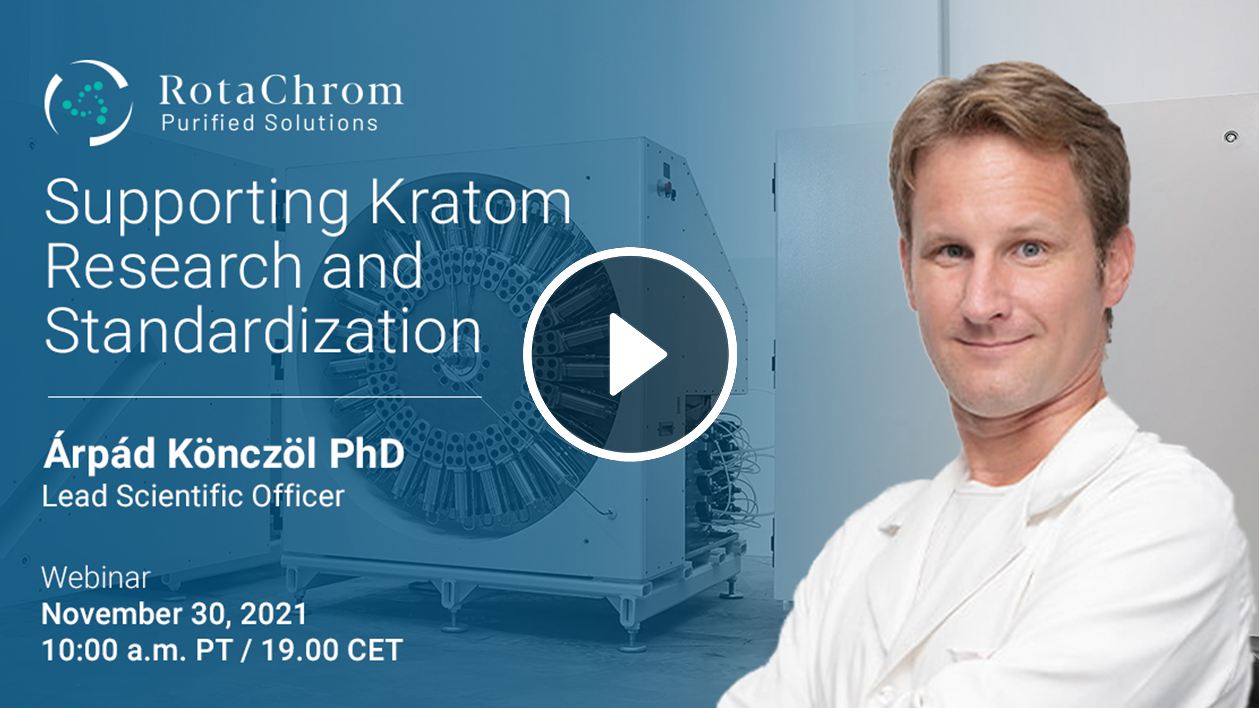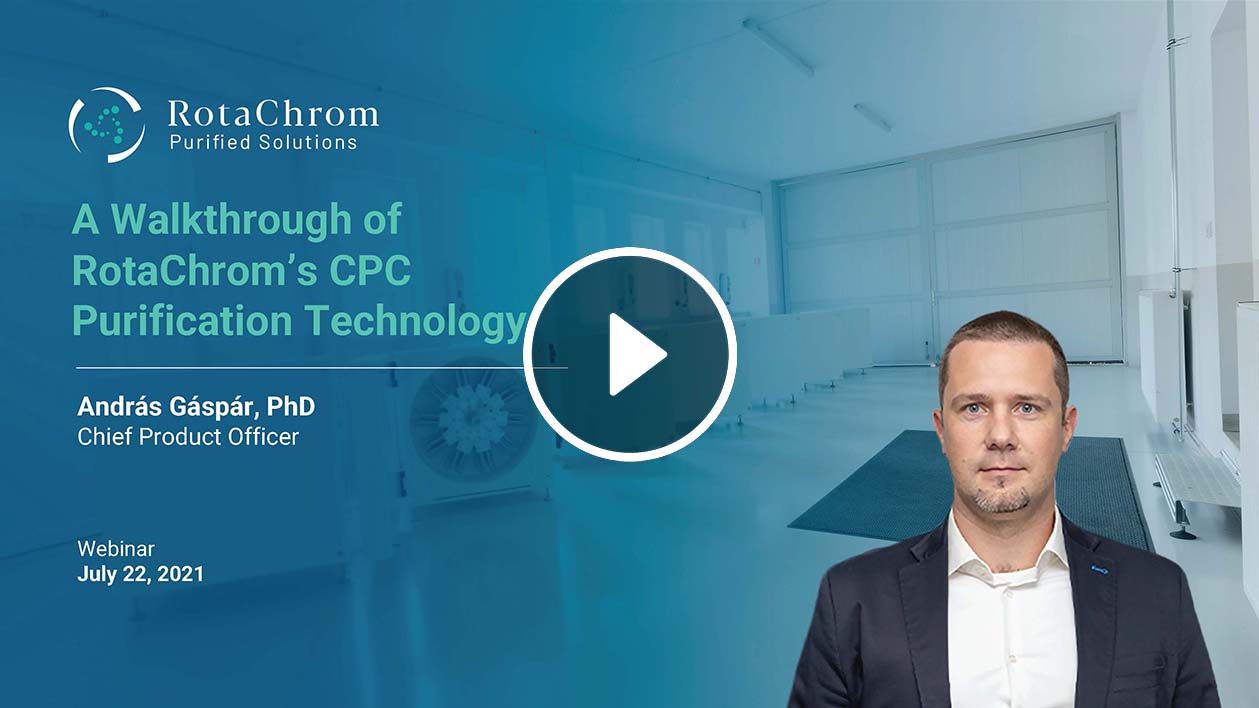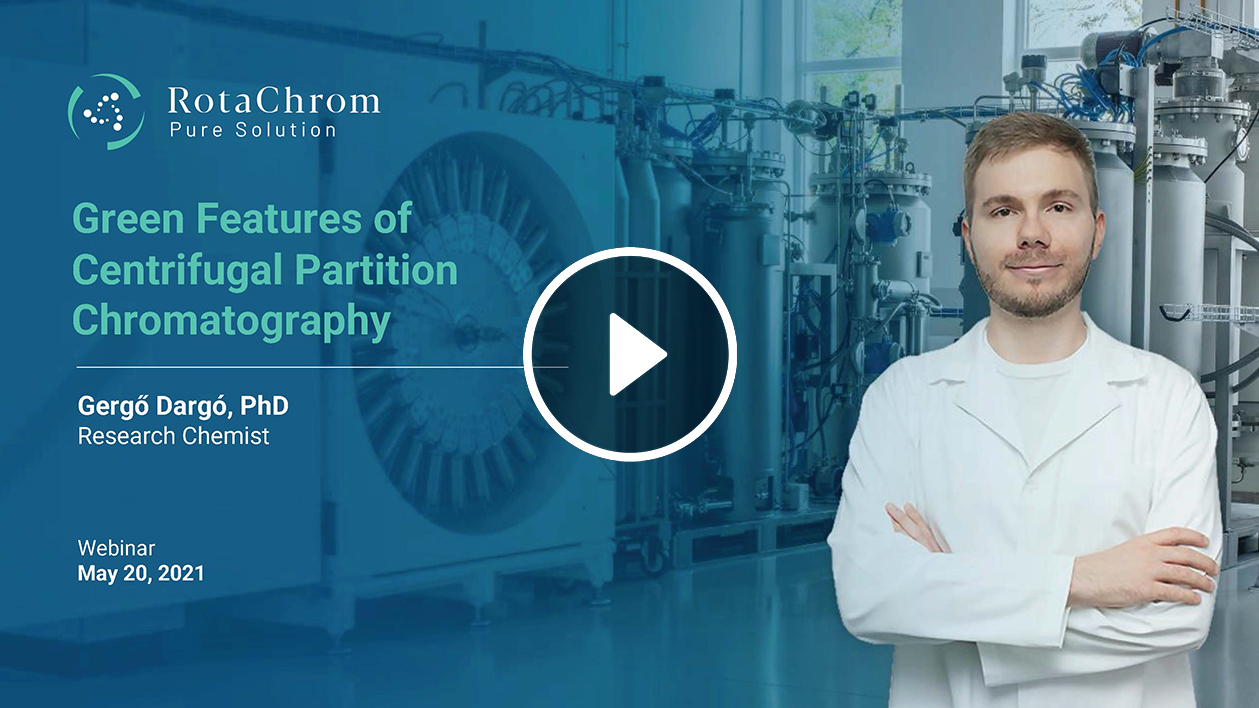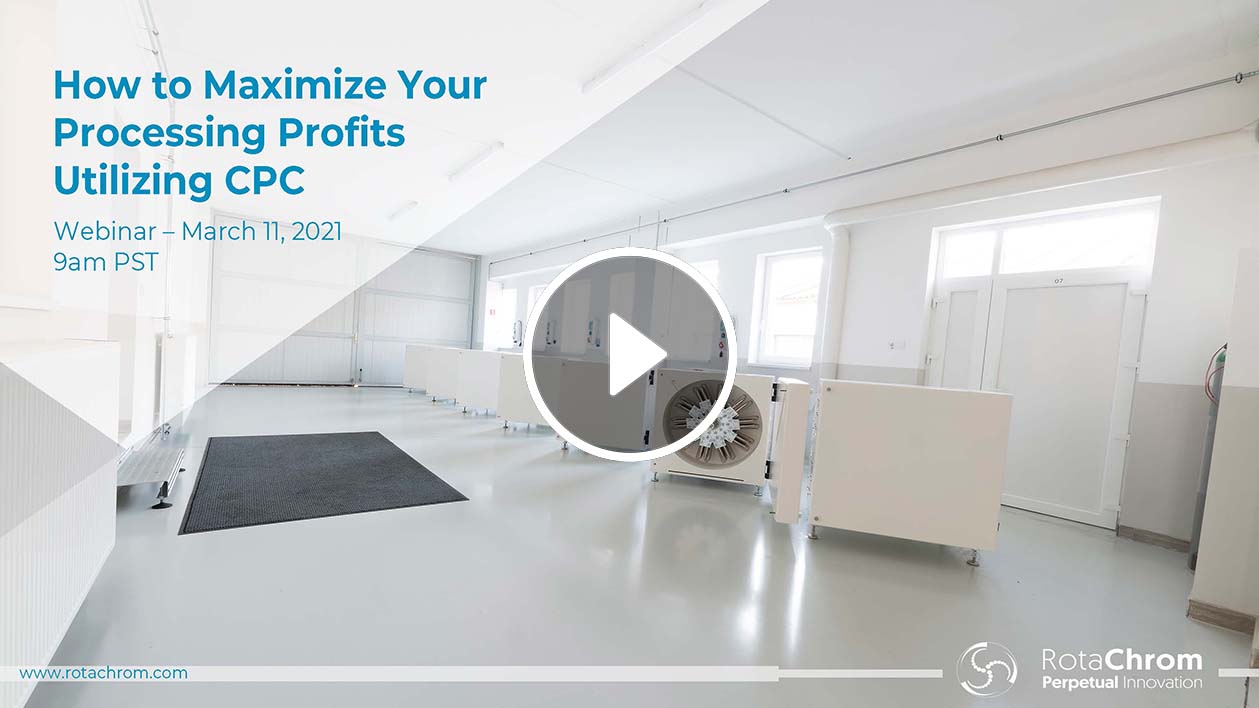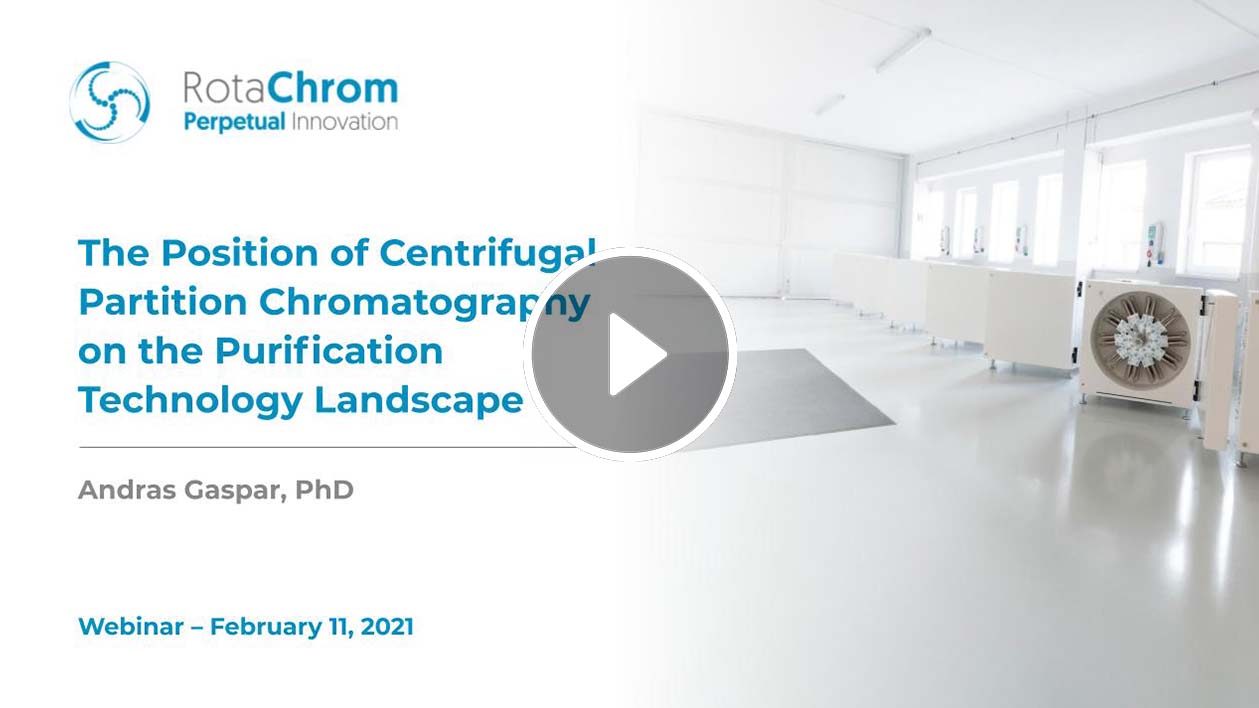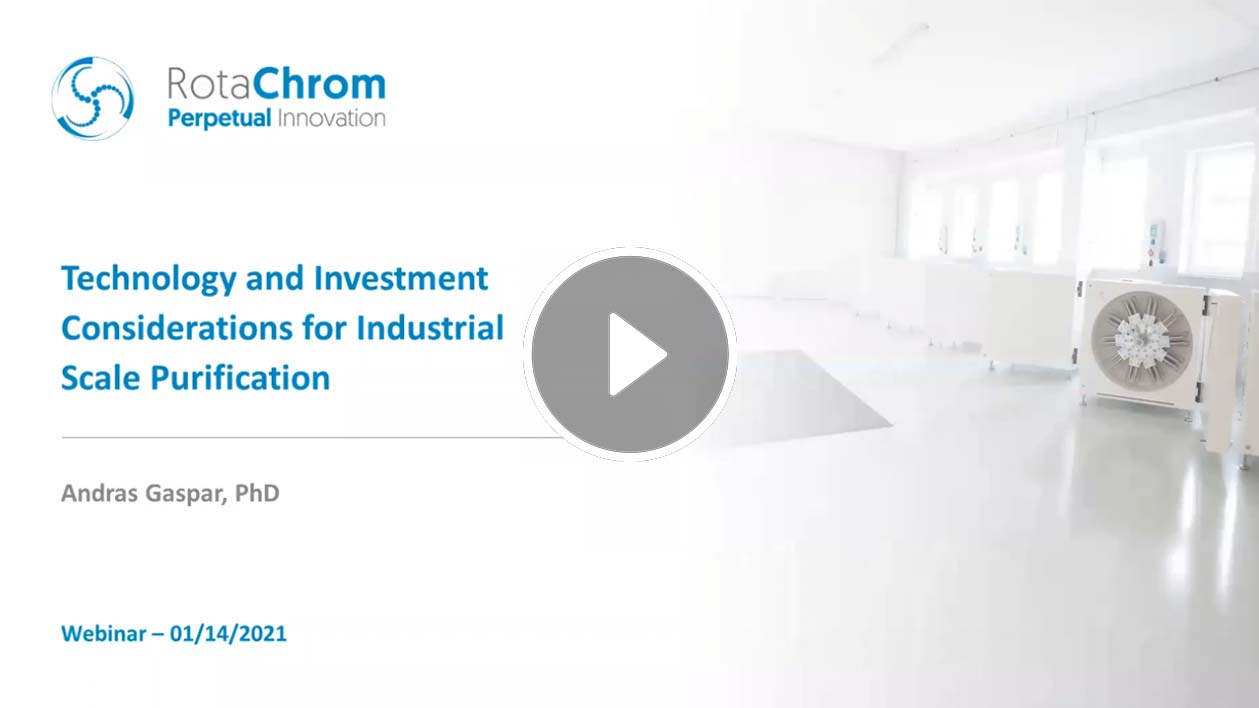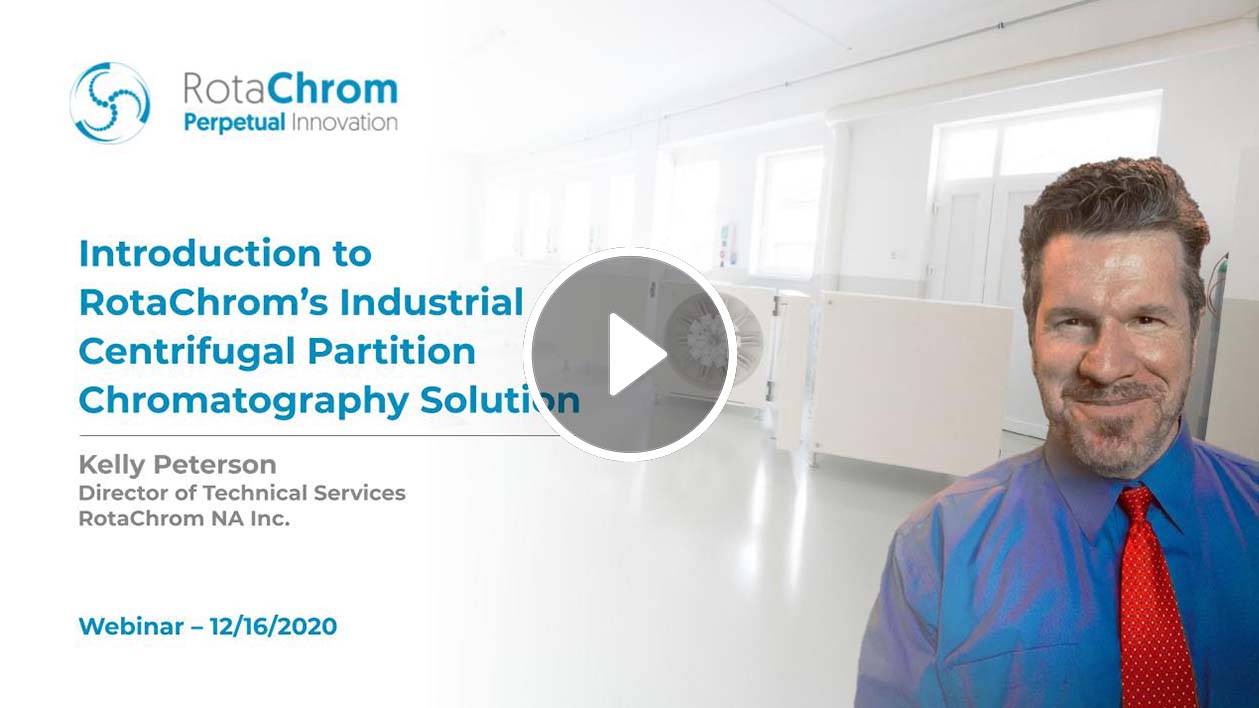Webinar 3 – CPC vs. Legacy Chromatography
In this webinar, RotaChrom’s Andras Gaspar, PhD gives a brief overview of legacy systems and applications of Chromatography. Additionally, he gives a comparative analysis of the advantages and key metrics of Centrifugal Partition Chromatography (CPC) as it relates to industrial-scale purification.
The focus will primarily be on the operation cost aspects of the technology, specifically the purification step, as it is the main cost contributing factor of the entire process. He also investigates what kind of options a client has today within the market.
Part 1: Industrial-Scale CPC
As a quick recap, CPC is also a chromatographic method with the slight difference that comes with some advantages but also requires a different thought process during the purification step. CPC is not something new from the theory side, however having an instrument that is truly operating at an industrial scale is new as the design and creation of such an instrument came with several technical challenges that had to be resolved.
Thanks to RotaChrom, today an industrial-scale CPC is available. Unlike traditional, legacy chromatography, where a stationary phase and their properties (available surface, pore size, etc.) define the retention and separation performance mainly, CPC uses only liquid phases. This means that one solvent is immobilized via gravitational force and the other, mobile phase is forced through in the form of tiny droplets. As a result of this main difference, the mass transfer and the separation are different, so it is not surprising that method development and capabilities to solve a separation issue have to be different as well.
While traditional chromatography increases the resolution by pushing the properties of the solid stationary phase, like particle size, to obtain a higher number of plates, CPC plays with selectivity to obtain the necessary peak to peak separation.
When we detail this main differentiator, it becomes more and more complex, but the bottom line is that CPC has the advantage over traditional chromatography to compensate for the lower plate number often with extreme selectivity numbers. Furthermore, CPC is also not as susceptible to samples with significant content of ballast materials, such as fermentation broth or chlorophyll, and can be loaded with much higher volume and concentration. This, and the fact that the stationary phase is refreshed basically between every loop, allows for CPC to operate not only with fine distillates but also with heavier crude input material. This does not deprecate the purification performance over time like in case of traditional chromatography where the initial part of the column with solid stationary phase degrades over time.
One of the most significant differences is that with CPC, there is an almost infinite combination of solvents. The challenge is to find the perfect combination that enables enough selectivity for the given separation problem. Apart from the fact that this effect creates an extremely flexible array of tools for the CPC separation, the method development results in a very cost-effective setup, where the final method on the machine utilizes the very same solvent system. and found, can be directly scaled for the operation.
The infinite combination of solvents also provides a high flexibility, so changing between product lines or COIs is easy. The same instrument can be used for targeted and non-targeted purification problems, as opposed to a single and well-defined compound.
Part 2: Ownership Cost Structure and Comparing Costs
When selecting a purification technology, you need to evaluate the total cost of ownership together with other considerations. Here are a few things to consider
Total cost of ownership:
- Price /Depreciation (scrap costs)
- Consumables/ waste disposal
- Direct Labor
- Overhead – people & materials
- Energy requirements
- Footprint /Facility costs
- Maintenance/ warranty costs
Additional considerations
- Safety (including open/closed system)
- Level of automation / integration
- Complexity /training time
- Uptime
- Versatility/ flexibility
- Downtime/ease of switching between methods
- Customer perception
- Environmental impact
One of the most important considerations is the load capacity as this will basically define the level of investment that will be required to address the task ahead. Finding a purification solution on an industrial scale is not the simplest task given that the industry is undergoing a lot of changes and the target keeps moving.
The second most important factor is the volume of the total consumables. The values are relative to the input material and it is obvious that technologies utilizing solid-stationary phases, mainly C18 Silica, are suffering significantly from a larger cost burden. Technologies where a higher relative throughput is achieved, this cost might be lower but still present. RotaChrom offers a low cost of consumables during THC remediation, making it one of the most cost-effective approaches for such purification.
When we exclude solvents and other running costs like electricity from the operational costs and only investigate the cost of the stationary phase where it is applicable, it is even more pronounced that running cost in case of Flash, PREP-HPLC, SFC, SMB, and MCSGP are mainly driven by the solid stationary phase cost.
Part 3: Purification Selection Support Tool
It took some time but we came up with a TCO simulation tool that enabled us to fully understand the cost structure and the individual contributing factors within our process. This detailed information is typically presented during our initial client discussions to help them better understand the cost implication on the investment side as well as the operating side.
From this cost breakdown, it is immediately visible that the main cost contributing factor to the purification step is the consumables. These are mainly the solvent, solid phase when applicable, and energy costs. Since these are the basic KPIs for the purification, we have focused on this and used these benchmarks as the main comparison points for the currently available techniques on the market.
Prior to any investments it is also advised to review the current competitive landscape and check which provider might be the best to deliver the right solution. In order to aid our clients, we have carefully investigated all current and emerging technologies and tried to compare our performance with those who are active in the cannabis and hemps space. 10 different relevant methods to the hemp industry with 18 different providers were reviewed and compared.
The majority of the applications are derived from chromatography, while some of them are taking a different approach. Amongst the chromatographic methods, most of the techniques are utilizing some type of solid stationary phase, influencing the OPEX values of that approach significantly as you will see in the upcoming slides. Techniques such as CPC and HSCCC do not require a solid stationary phase to achieve separation, but still represent a significant volume of solvent, which needs to be addressed during the production.
Alternative technologies such as Harmonic Distillation, MIP or SOP such as T/SEP have emerged in the THC remediation market and yet have limited technical and financial presence in this market and based on our current belief these are only focusing on the THC remediation.
For more information about the TCO calculator and a comparative cost analysis of various types of chromatography, listen to the complete webinar or the podcast on this topic.
About: Andras Gaspar, Ph.D., is RotaChrom’s Chief Product Officer. Andras studied bioengineering at the Budapest University of Technology and Economics and went on to earn his Ph.D. in chemistry at the Technical University of Munich. After more than a decade of engineering work at IBV Hungary, Gates Corporation, and Continental ContiTech, Andras joined RotaChrom Technologies in 2020.
WATCH ALL WEBINARS

11-30-21
Supporting Kratom Research and Standardization
7-22-21
A Walkthrough of RotaChrom's CPC Purification Technology
4-15-21
Pesticides Remediation by Centrifugal Partition Chromatography
3-11-21
How to Maximize Your Processing Profits Utilizing CPC
2-11-21
The Position of Centrifugal Partition Chromatography on the Purification Technology Landscape
1-14-21
Technology and Investment Considerations for Industrial Scale Purification
12-16-21
Centrifugal Partition Chromatography on an Industrial Scale
QUESTIONS? GET IN TOUCH!


